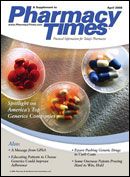Publication
Article
Generic Supplements
Educating Patients to Choose Generics Could Improve Adherence
Author(s):
Teaching patients about the benefits of generic replacements for their branded medications is a major step to improved adherence and cost savings.
Mr. Lamb is a freelance pharmacywriter living in Virginia Beach,Virginia, and president of ThoroughCursor Inc.

Of all prescriptions dispensedin the United States in2006, 63% were filledwith generic drugs. In retailpharmacy settings, where patientshave the most choice over what theyreceive, the ratio of generics tobrands was 57% to 43%.1,2
These statistics are indicative of atrend illustrated in Table 13-6 forpharmacists, prescribers, and patientsto opt for generics. With about75% of reference drugs listed in theOrange Book having at least 1generic equivalent approved by theFDA, however, considerable roomfor growth still exists in the genericdrug market.
A key to realizing this growth is inchanging some patients' negativeviews of the efficacy and safety ofgenerics. Pharmacists have a role toplay in this, with the payoff beingincreased adherence to medicationtherapy.
Myths of Inferiority Persist
In a 2006 Wall Street JournalOnline/Harris Interactive poll, 68%of more than 2200 US adults whoregularly purchase prescription medicationsaid that they would be atleast somewhat likely to choosegenerics over brand name drug productswhen given a chance.7 An earliersurvey by the same organization indicatedthat their number-1 reason forpreferring a generic was that it "wasless expensive" than its brandedcounterpart.
Table 1
Growth in Generic Drug Prescription Volume in the United States, 2003-2006
Year
Percent of Total Volume
2003
43
2004
47
2005
60
2006
63
Source: references 3-6.
These data, along with opinionsexpressed in recent surveys ofGerman and Norwegian patients,confirm that patients worldwideunderstand at least 1 thing aboutgeneric drugs very well: they areinexpensive.8,9
This perception of "cheapness,"however, can unfortunately extendbeyond price to quality. As theauthors of the Norwegian studynoted, "Generic substitution, for anumber of patients, is not consideredan equal alternative to brandeddrugs."9 More than 1 in 5 of theindividuals surveyed had reported"an overall negative experience"with a substituted generic. Such negativityhas persisted for decades. Areport in the June 1980 issue ofJournal of Consumer Affairs notesthat patients, pharmacists, and physiciansin Alabama expressed concernsabout generic drugs' "safety,liability, and manufacturer performance."10
The FDA cites the following as theforemost "myths" patients continueto believe about generic drugs:
- They take longer to act in the body
- They are not as potent as brand name drugs
- They are not as safe as brand name drugs
- They are often made in substandard facilities, while brand name drugs are made in modern manufacturing facilities
- They are likely to cause more side effects11
The agency offers the checklist inTable 2 as a tool pharmacists can useto dispel these myths. Other freelyavailable patient education materialscan be found at www.fda.gov/cder/consumerinfo/generic_all_resources.htm.
Patients' questions regarding genericdrugs may not be limited to justquality, of course. Dosages of thesame drug from different manufacturerswill have different colors,shapes, and markings, and may sometimesdiffer in taste. Pharmacistsmust be ready to confirm that thegeneric product each patient receivesis equivalent to what the patient hasreceived previously and to discusshow characteristics such as tabletshape will not affect how a drugworks. At the same time, all patientreports of problems with new productsmust be taken seriously.
Although the influence that healthcare providers have over patients'choice of generics has been found tobe limited, this influence is by nomeans insignificant. Twenty-eight percentof US patients who chose anunbranded product said they did soprimarily because their pharmacist orphysician recommended doing so orhad assured them that a generic wouldwork as well as a brand.12 Also, whileacknowledging that "the patient viewthat inexpensive drugs [are] inferiormay be difficult to rectify in the shortterm," authors of the report onGerman patients' views noted thathealth care providers "are in an idealposition to inform their patients adequatelyabout the equivalence ofbrand name and generic drugs."8
Lower Costs, Better Drug Taking

Helping patients use more genericsis important because all theavailable evidence shows that individualsare more adherent to drugtherapy when they pay less for theirmedications.
Researchers at RAND Corporationrecently conducted a meta-analysis ofpublished studies of how insuranceplan rules regarding copayments andcoverage limitations affected patients'pharmacy use, drug spending, andhealth outcomes. Writing in the July4, 2007, issue of the Journal of theAmerican Medical Association, theresearchers reported that findingsfrom 132 studies showed that "increasedcost sharing is associatedwith lower rates of drug treatment,worse adherence among existingusers, and more frequent discontinuationof therapy. For each 10%increase in cost sharing, prescriptiondrug spending decreases by 2% to6%, depending on class of drug andcondition of the patient."13 The researchersalso determined that lowerdrug spending was positively associatedwith higher spending on othermedical services such as hospitalizations,especially among patients withcongestive heart failure, high cholesterol,diabetes, and schizophrenia.
Table 2
FDA Requirements for Brand Name and Generic Drugs
Brand Name
Generic
For reformulations of a brand name drug or generic versions of a drug, FDA reviews data showing the drug is bioequivalent to the one used in the original safety and efficacy testing.


FDA evaluates the manufacturer's adherence to good manufacturing practices before the drug is marketed.


FDA reviews the active and inactive ingredients used in the formulation before the drug is marketed.


FDA reviews the actual drug product.


FDA reviews the drug's labeling.
Manufacturer must seek FDA approval before making major manufacturing changes or reformulating the drug.


Manufacturer must report adverse reactions and serious adverse health effects to the FDA.


FDA periodically inspects manufacturing plants.


FDA monitors drug quality after approval.


Source: reference 11.
References
- Generic Pharmaceutical Association. Statistics. GPhA Web site. www.gphaonline.org/Content/~default.htm. Accessed September 2, 2007.
- New IMS Health Report Finds Generic Drugs Used More in Part D Than Commercial Market. Pharmaceutical Care Management Association press release. August 2, 2007.
- IMS Reports 11.5 Percent Dollar Growth in '03 U.S. Prescription Sales. IMS Health press release. February 17, 2004.
- IMS Reports 8.3 percent Dollar Growth in 2004 U.S. Prescription Sales. IMS Health press release. February 14, 2005.
- Van Arnum P. Opportunities Abound for Generic Drugs. PharmTech.com. www.pharmtech.com/pharmtech/~id=434545. Accessed August 30, 2007.
- IMS Reports U.S. Prescription Sales Jump 8.3 Percent in 2006, to $274.9 Billion. IMS Health press release. March 8, 2007.
- Low-Priced Generics Likely to Attract Large Share of Prescription Drug Sales. Harris Interactive press release. October 19, 2006.
- Hughes B. Almost All Americans Believe that the Financial Burden of Drug Costs for Chronically Ill Patients Is Greater in U.S. than in Canada. Wall Street Journal Online/Harris Interactive Web site. www.harrisinteractive.com/~NewsID=836. Accessed August 31, 2007.
- Himmel W, Simmenroth-Nayda A, Nieblung W, et al. What do primary care patients think about generic drugs? Int J Clin Pharmacol Ther. 2005;43:472-479.
- Kjoenniksen I, Lindbaek M, Granas A. Patients' attitudes towards and experiences of generic drug substitution in Norway. Pharm World Sci. 2006:28:284-289.
- Mason JB, Bearden WO. Generic Drugs: Consumer, Pharmacist and Physician Perceptions of the Issues. J Consum Aff. 1980;14:193-206.
- FDA Ensures Equivalence of Generic Drugs. FDA Web site. www.fda.gov/cder/consumerinfo/generic_equivalence.htm. Accessed August 30, 2007.
- Goldman Dana P, Joyce GF, Zheng Y. Associations with Medication and Medical Utilization and Spending and Health. J Am Med Assoc. 2007;298:61-69.







